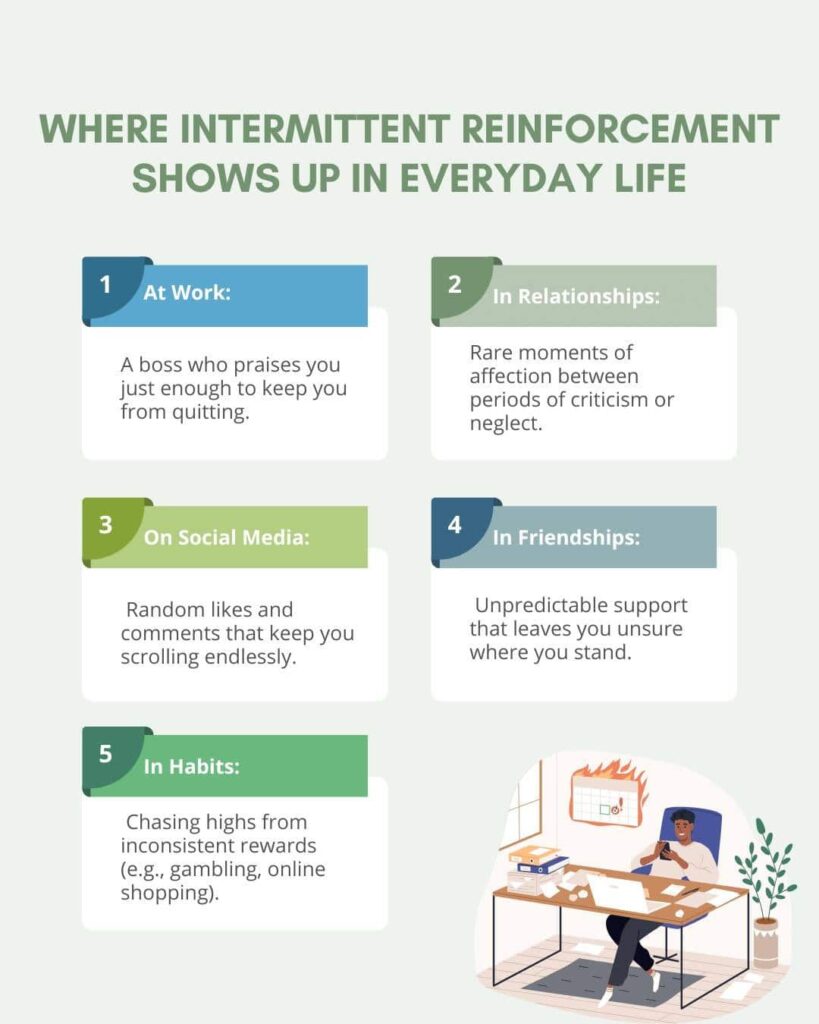Intermittent reinforcement is a behavioral pattern where rewards like affection, attention, or validation show up randomly. It is the reason you’re still thinking about someone who sent five texts and then disappeared like a raccoon in a garbage fire. You’ve read the messages. You’ve dissected the hieroglyphics (emojis). You’ve tried to make sense of three decent dates followed by total silence. What’s left isn’t clear, at all. And now your nervous system is craving this person and convincing you that, “if you just figure out what went wrong in the relationship, you’ll get closure.”
Thrailkill et al. (2023) demonstrated that people trained under intermittent reinforcement took significantly longer to extinguish a learned behavior compared to those trained with consistent reinforcement. For individuals with anxious or fearful-avoidant attachment styles, inconsistent behaviors in a relationship trigger a series of emotional reactions and behaviors. This cascade of events can lead to a history of volatile encounters. We want you to know that during such stressful events, your brain is doing the best it can to help you through a difficult, unpredictable time. This desire for human connection is at the core of the issue. Let’s get into this and learn how to identify and challenge intermittent reinforcement cycles.
Unpredictability in Relationships is Intermittent Reinforcement
Just like a slot machine gives unpredictable rewards (you win occasionally but not every time), some relationships deliver affection, attention, or intimacy unpredictably. That unpredictability increases dopamine release in the brain, making the behavior more addictive. This pattern conditions and reinforces behavior. In experimental settings, reward schedules that alternate between reinforcement and omission significantly increase the persistence of learned behaviors, even when they stop producing the desired outcome (Jean-Richard-Dit-Bressel et al., 2018). The more inconsistent the affection, the harder it becomes to walk away from conflict.
On-Again, Off-Again Relationships
On-again, off-again relationships thrive on intermittent reinforcement where the relationship becomes a psychological trap of unpredictable rewards like affection after a breakup that create an addictive cycle. Just like gambling, the inconsistency makes the “highs” feel more intense, keeping partners hooked in relationships despite the dysfunction. The brain clings to hope during “off” phases, while reunions act as dopamine-fueled reward system that reinforces the toxic pattern. This emotional rollercoaster can feel like love, but it’s often attachment to chaos rather than stability. Breaking free requires recognizing the cycle and actively choosing consistency. This intermittent reinforcement loop can be broken step-by-step.
How to Break the Intermittent Reinforcement Loop

A step-by-step guide to recognizing, interrupting, and healing the emotional patterns caused by intermittent reinforcement in dating and relationships.
Step 1. Name the Pattern
Say the words out loud: “This is intermittent reinforcement. This craving is a conditioned response, not a reflection of compatibility.” Naming reduces shame and increases executive functioning, which allows for more effective self-regulation.
Step 2. Disrupt the Loop
The most effective way to extinguish conditioned behavior is to remove access to the cue. That means: Stop checking for their messages, archive the thread, set external limits if necessary. Understand that time for yourself when you need it most is not ghosting. Take all of the time that you need.
Step 3. Introduce Safe, Consistent Contact
The nervous system cannot unlearn chaos in isolation. Rewire it by seeking out people who are emotionally consistent. These moments of co-regulation help shift your baseline response to intimacy. Freeland (2002) showed that maintenance of behavioral change is stronger when stable cues are present across reinforcement and extinction phases. In relational terms: surround yourself with stability.
Step 4. Practice Repatterning
Your nervous system doesn’t understand ideas. It understands patterns. Practice secure attachment behaviors with yourself and others. Set boundaries. Follow through. Notice how boredom can signal safety. This is the work of reparenting.
Final Thought
Intermittent reinforcement is not romantic. It is one of the most powerful behavioral traps ever studied, and your brain is especially susceptible to it in moments of emotional vulnerability. What feels like chemistry may be a nervous system attempting to complete an unresolved pattern. But patterns can change. And craving isn’t proof of love. It’s often just proof of old training. If you’re ready to understand that craving, interrupt it, and slowly rewire what love feels like, you’re in the right place.
Keep Reading
- Alcohol molecule coupling: A universal approach to modulating amorphousness in vanadium-based cathodes for high-rate and durable aqueous zinc-ion batteries
- Reducing emissions and air pollution from informal brick kilns: Evidence from Bangladesh
- Chronic ethanol exposure produces sex-dependent impairments in value computations in the striatum









